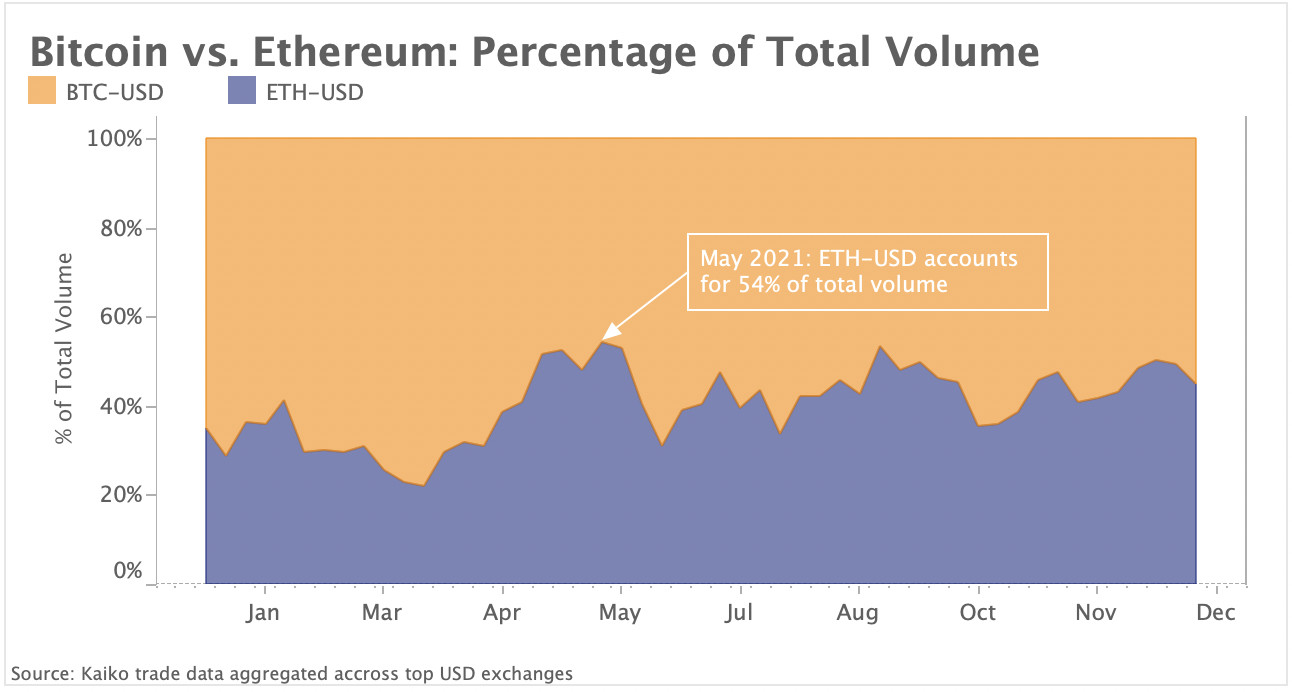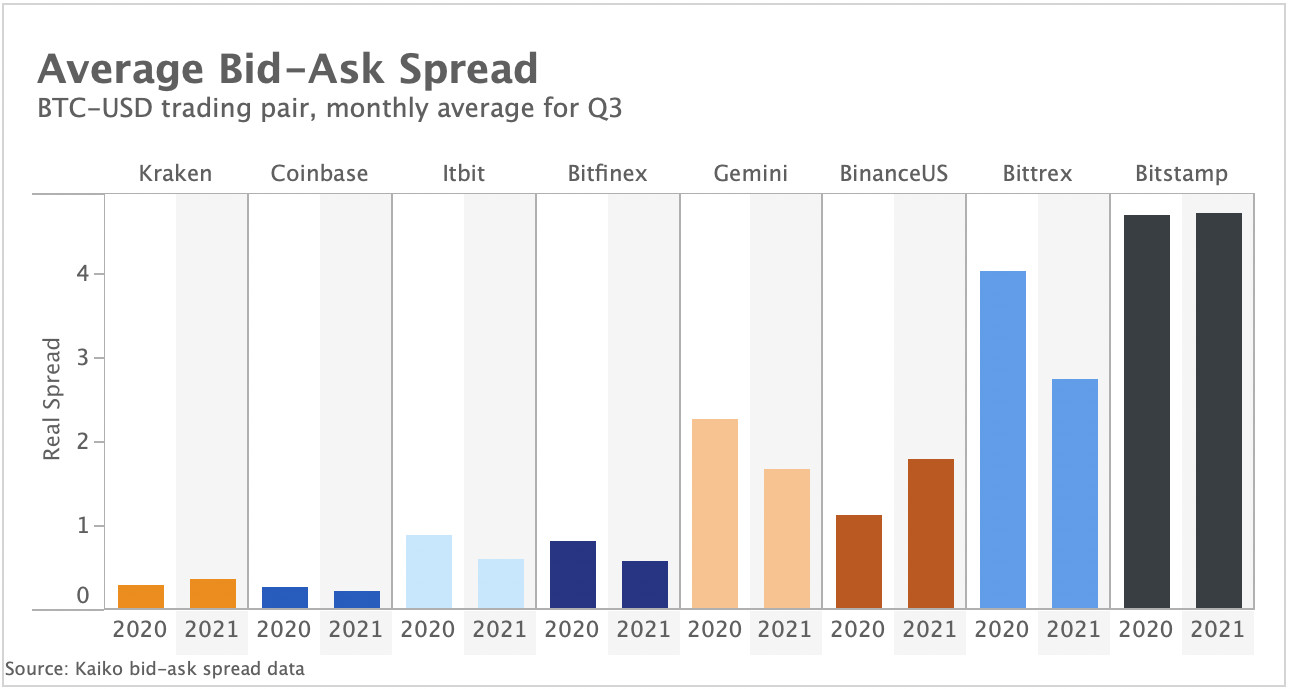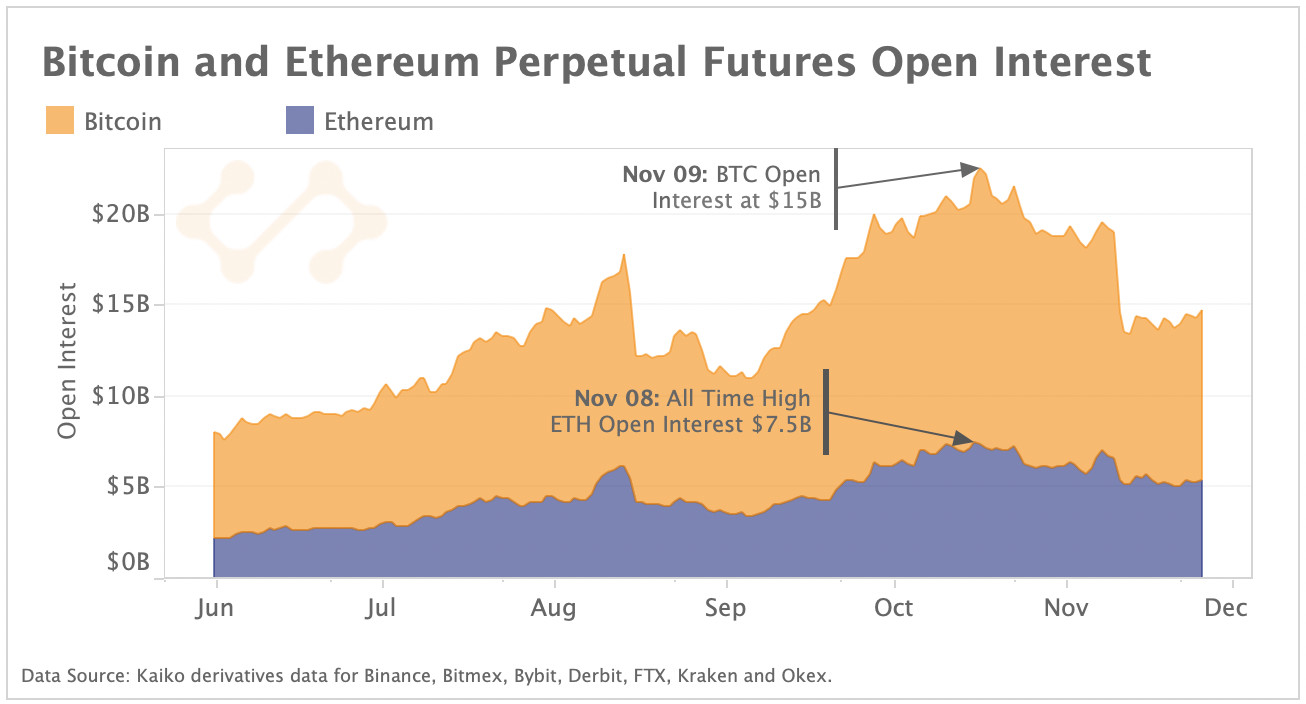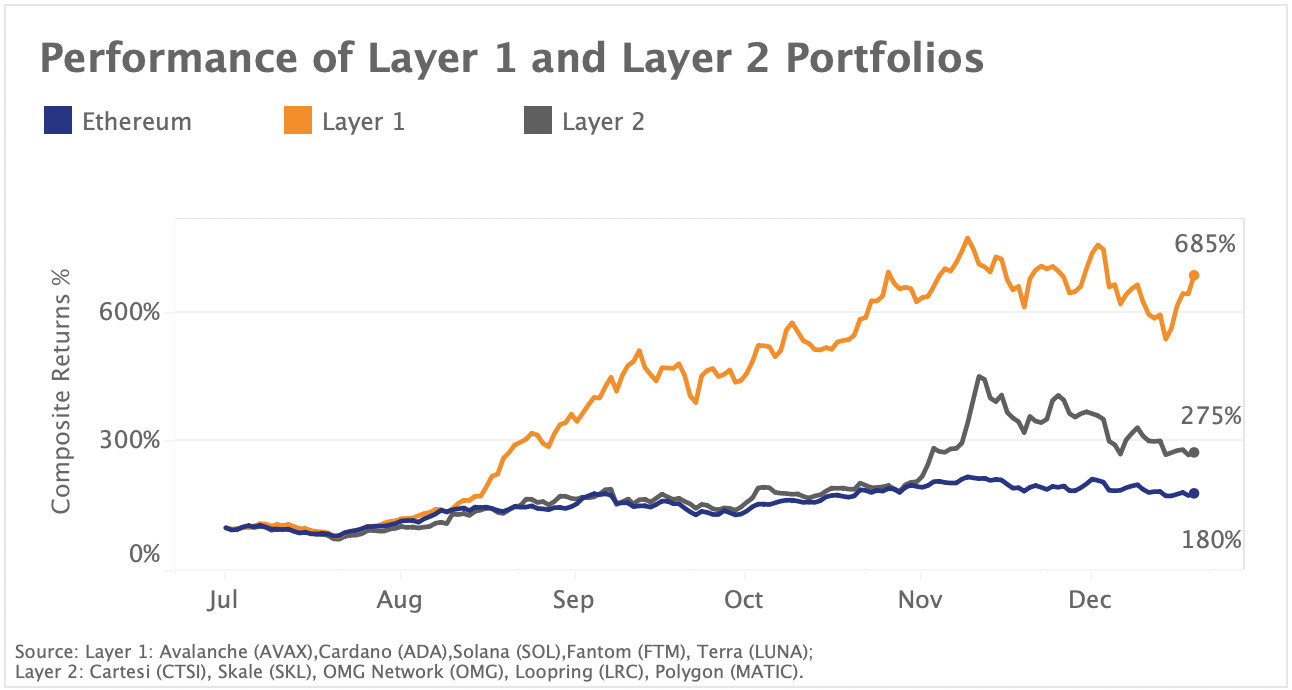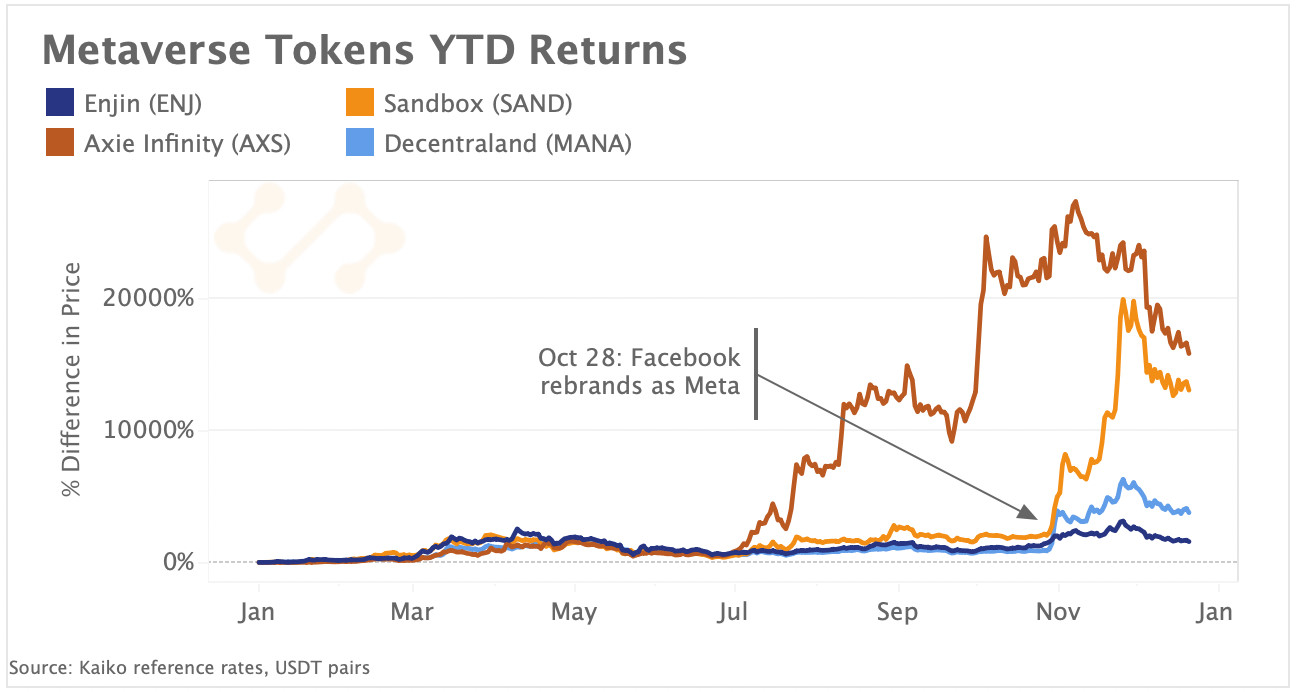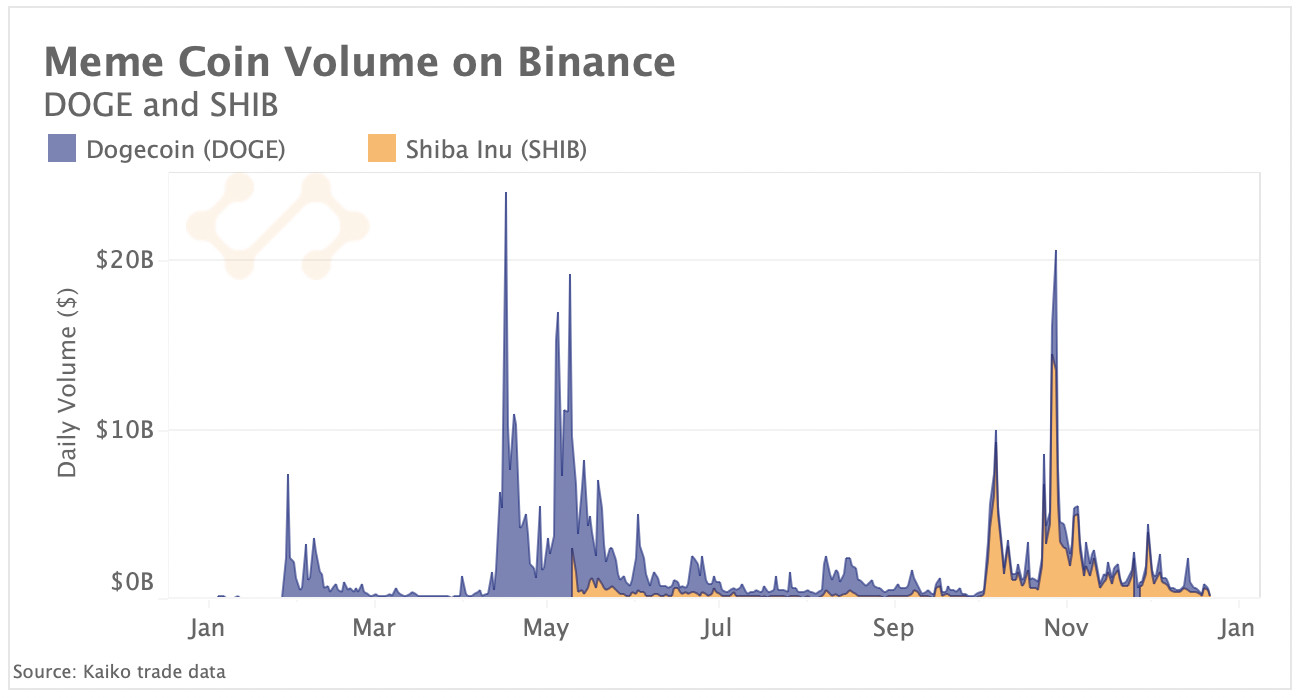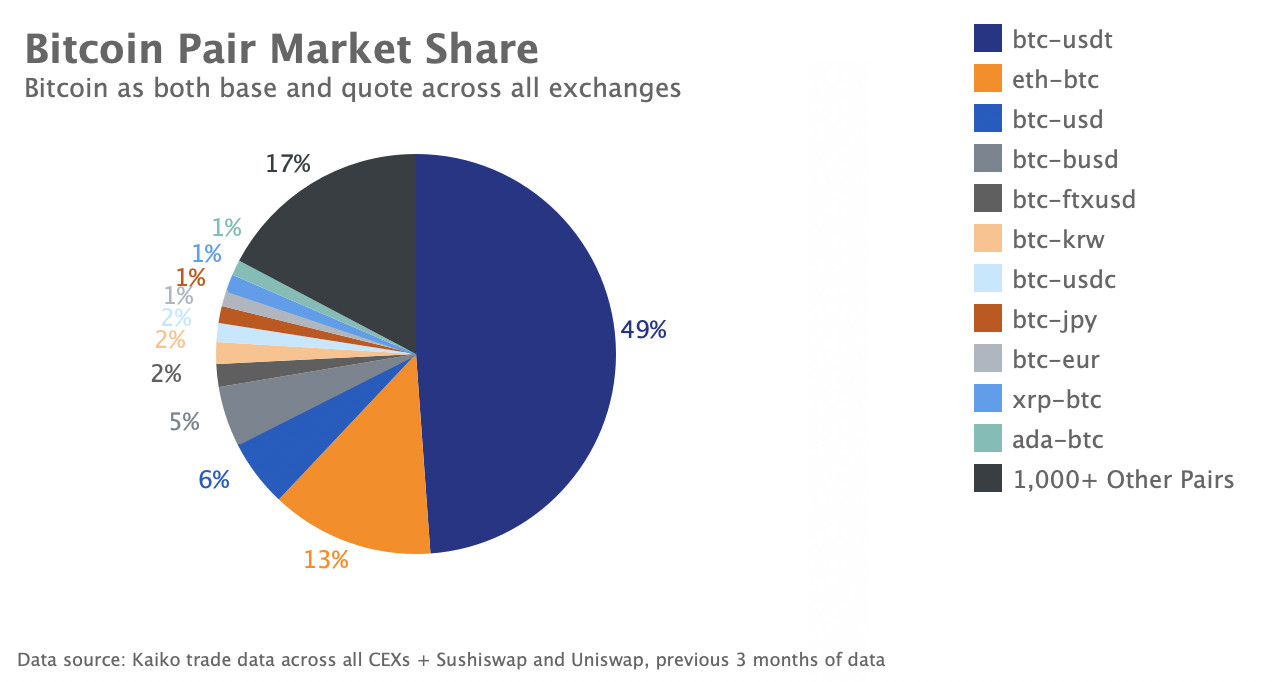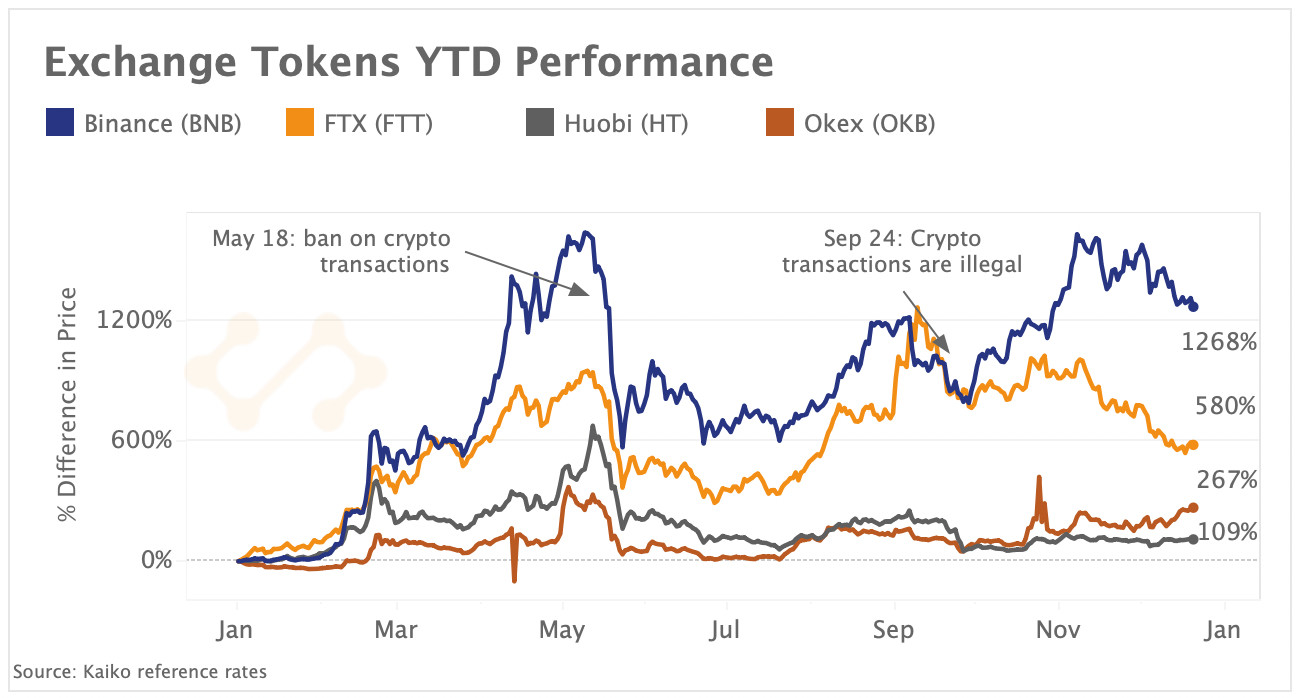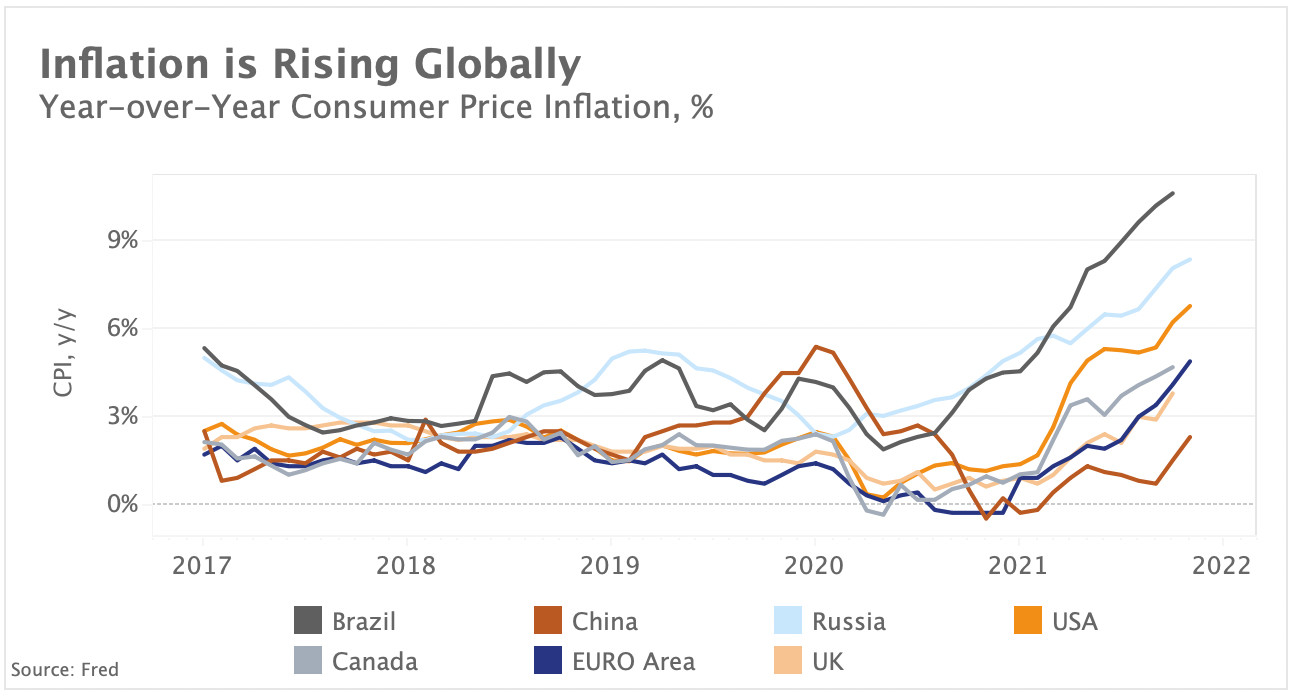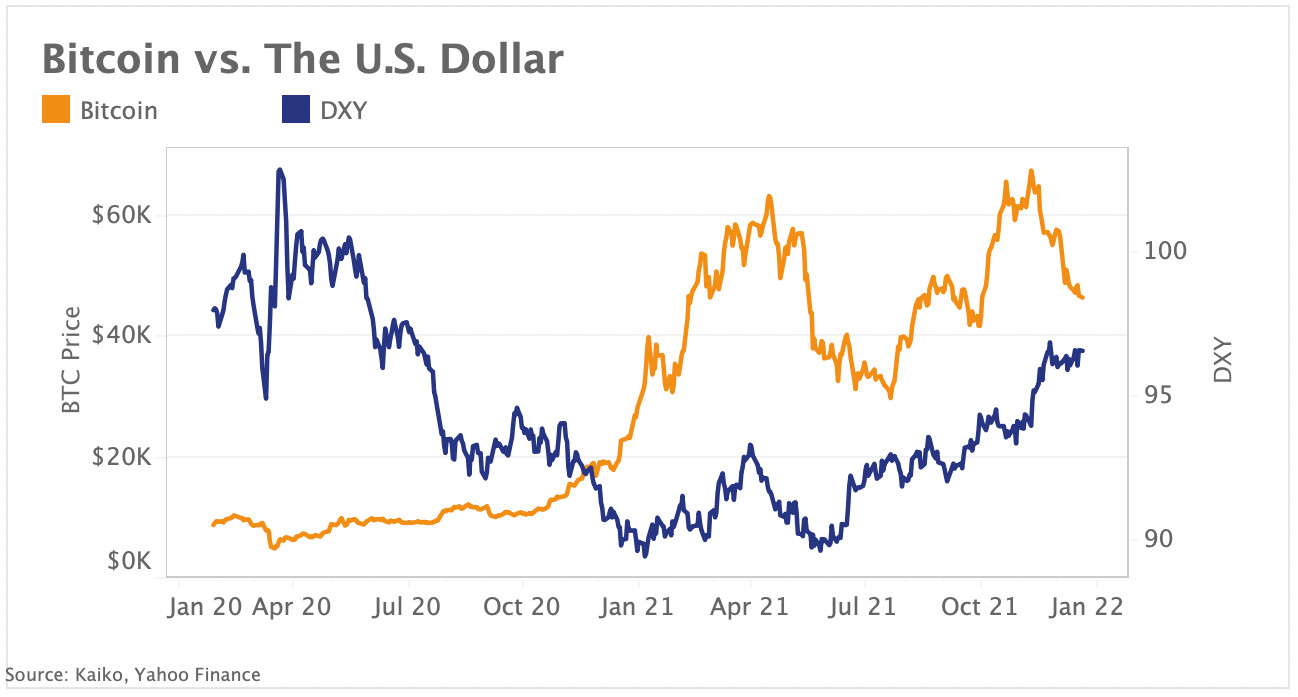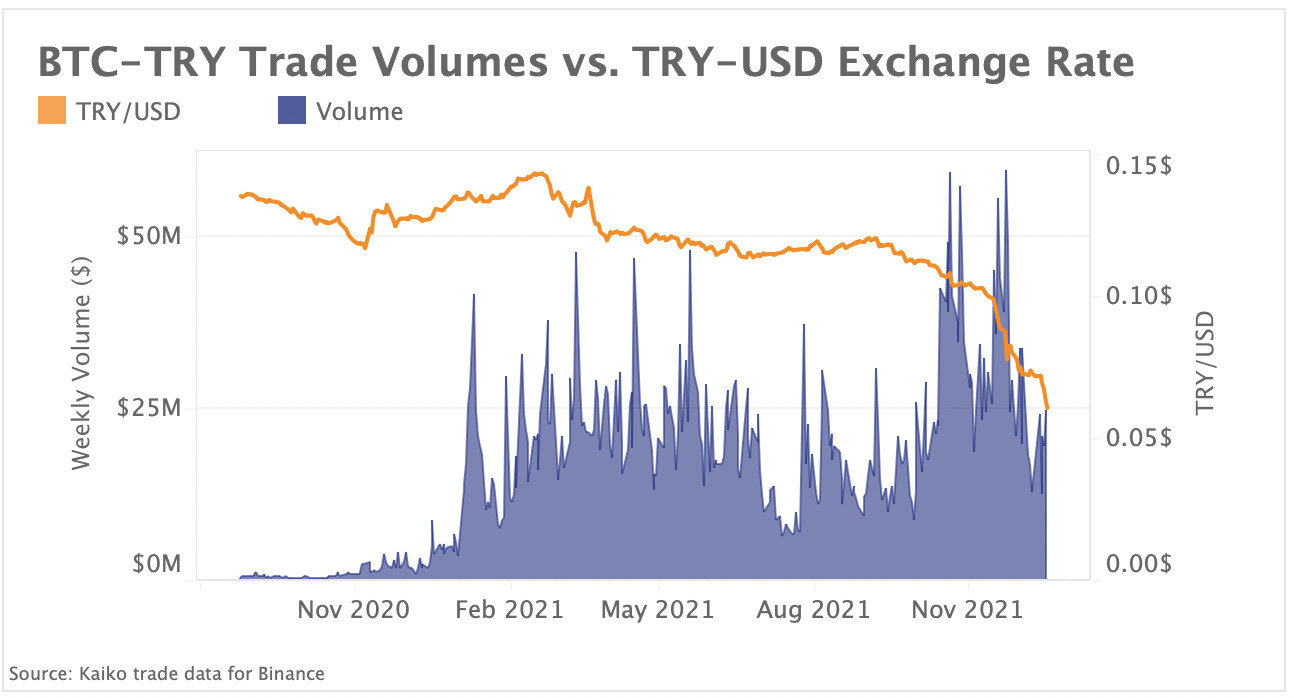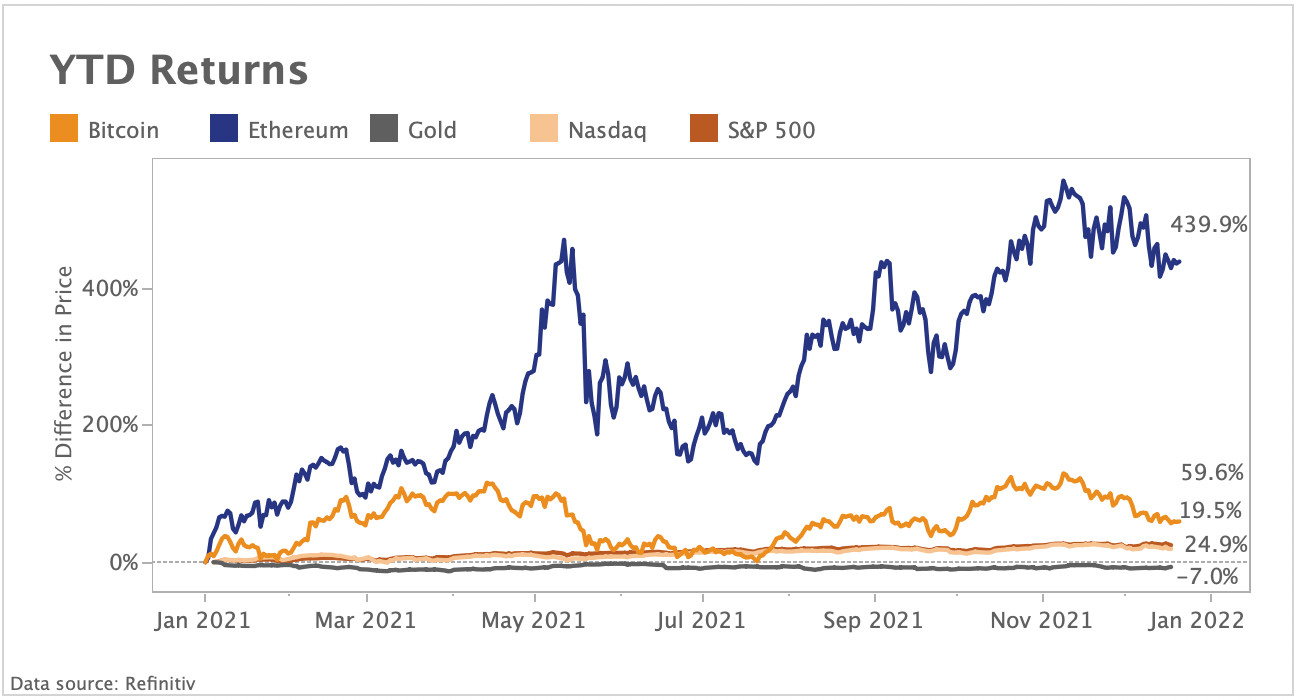A summarizing review of what has been happening at the crypto markets of the past year. A look at trending sectors, liquidity, volatility, spreads and more. The year report is a cooperation with market data provider Kaiko.
2021 started with all time highs and is ending on a bearish note, but so many industry-defining events happened in between that a single newsletter is hardly enough to capture the year. Meme tokens, the metaverse, the stablecoin crackdown, liquidation cascades, the China ban, Coinbase's IPO, the first Bitcoin ETF, record VC investment, global inflation, and a new Covid variant — this year proved anything but ordinary for the crypto industry. In this special edition of Kaiko's weekly research newsletter, we selected 15 of our favorite charts that we thought best captured 2021.
Trade volumes are way up
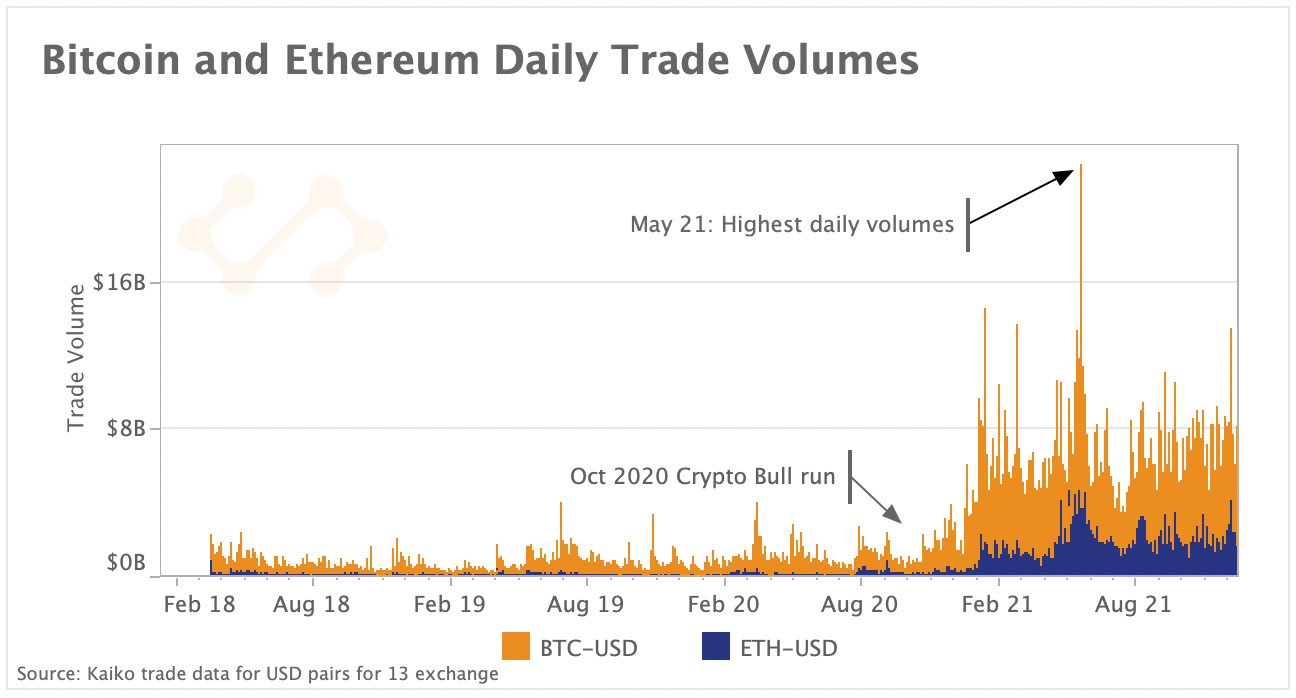
In January 2021, scores of companies, funds and high-profile investors began purchasing crypto en masse, which contributed to the unprecedented bull run that saw Bitcoin break $60k. Exchanges facilitated record levels of transactions, and despite a slight stagnation since May, volumes are still magnitudes greater than any previous year. Soaring volumes (and revenues) cemented exchanges as global behemoths, marked by Coinbase's IPO, FTX's massive marketing initiatives, and Binance's continued dominance.
Ethereum market share surged
2021 was the year that investors started taking Ethereum seriously. While a marketcap "flippening" is still far off, the market share of trade volume flipped on numerous occasions. At several points, more than 50% of daily trade volume was for Ethereum in a potent sign that investors are seeking to diversify beyond Bitcoin.
Average liquidity improved
Liquidity is a tough subject in cryptocurrency markets, which remain highly fragmented across hundreds of crypto assets and dozens of exchanges. The bid-ask spread is one of the most reliable measures for liquidity but doesn't capture the whole story considering market maker fees vary considerably across exchanges. However, when comparing the difference in liquidity from Q3 2020 to Q3 2021 for BTC-USD trading pairs, we can observe that on most exchanges the average spread has narrowed, which is a good sign. Liquidity is still an issue for altcoin pairs, which often struggle to attract sufficient depth.
Open interest broke all time highs
While derivatives have drastically improved the price discovery process in cryptocurrency markets, the excessive use of leverage has repeatedly contributed to major price crashes. In 2021, many exchanges restricted leverage for the first time in response to growing regulatory oversight, which over time could reduce the number of liquidation cascades. Open interest for BTC and ETH perpetual futures broke all time highs throughout the year despite the new limits. Ethereum in particular saw growing investment from derivatives traders, although open interest still remains ~1/3 that of Bitcoin.
Ethereum scalability concerns propelled L1s and L2s
Perhaps the biggest technical headache for the cryptocurrency industry has been Ethereum's record high transaction fees and network congestion, making protocols on the network practically unusable. This generated unprecedented investor enthusiasm for "Layer 1" and "Layer 2" tokens. L1 protocols are alternate blockchain networks, often known as “Ethereum Killers,” while L2 protocols are scaling services for the Ethereum blockchain designed to process transactions off-chain and reduce congestion. The performance of the top five tokens in each category far surpass Ethereum's returns since Q3, although actual usage of these protocols still remains far lower.
DEXs became too expensive
In DeFi, transaction count often reveals a lot more about a protocol's usage than trade volume, which can be skewed by just a few whales. Today, the leading Ethereum DEXs process less than 50k trades a day and trade counts have remained flat throughout most of 2021, in contrast to volumes which have increased. This is largely due to record high fees on the Ethereum network, which make transacting economically unviable for retail traders.
The Metaverse went mainstream
Facebooks big “Meta” rebrand proved to be an extremely bullish signal for several of the biggest NFT projects, which captured attention across practically all mainstream cultural segments. NFT and metaverse platforms are trendier than ever and their affiliated tokens saw massive returns throughout 2021, with Axie Infinity and the Sandbox leading the way. With record levels of VC investment, we can expect this sector of the crypto industry to continue to attract mainstream attention into the new year.
Meme coins became reality
First it was Dogecoin. Then it was Shib. Meme coins had their moment thanks to the perfect confluence of Elon Musk's twitter activity and a revolution in retail trading that has everyone scratching their heads about the true nature of value. On Binance alone, meme coins accounted for hundreds of billions in trading activity and dogecoin remains one of the top 15 crypto assets by market cap.
The stablecoin crackdown began
Nearly 50% of all Bitcoin trades are executed using Tether, which today is the most structurally critical stablecoin in the industry. Approximately $100 billion in Tether trade volume happens every day across dozens of exchanges and throughout 2021 regulators finally started paying attention, especially in the United States. The biggest focus was on the controversial makeup of Tether's reserves, although Circle's USDC also faced scrutiny.
The China ban threatens exchanges
In September, China officially banned all cryptocurrency transactions following a soft ban in May, sending waves throughout the industry. All Bitcoin miners were forced to close shop and exchanges had to completely vacate the country. Binance, Okex, FTX and Huobi have historically catered for an Asian user-base, and the ban sent their exchange-issued tokens plummeting. Exchange tokens have mostly recovered and are still in-the-green for 2021, although the full effects of the ban are likely not to be felt for some time.
The first U.S. Bitcoin ETF was approved
The approval of the first Bitcoin ETF in the United States was a historic milestone for the cryptocurrency industry nearly a decade in the making. The ProShares BITO ETF — which tracks Bitcoin futures trading on the Chicago Mercantile Exchange — garnered more than $1 billion in trade volume on the first two days of trading and nearly maxed out the contract purchasing limit CME imposes for a single entity. Two other ETFs launched in succession, although ProShare's continues to benefit from first-mover advantage as measured by NAV. Canada was the first country to approve a Bitcoin spot ETF earlier in the year, which remain the most popular investment vehicles.
Inflation is on a global rampage
Inflation is no longer transitory. Around the world, prices are rising rapidly caused by a combination of supply bottlenecks, pandemic-era monetary policy, and a rebound in demand. This has inevitable effects on global financial markets, including cryptocurrencies, which are often treated as risk-off assets despite their inflation-hedge narrative. The early months of 2022 will be crucial for understanding how Bitcoin reacts to contractionary macro conditions.
The U.S. Dollar is up
Throughout 2020, Bitcoin and the U.S. Dollar held a strong inverse correlation. The pandemic-induced economic crisis and subsequent monetary stimulus caused the DXY (USD Index) to plummet as Bitcoin soared to new all time highs. In 2021, this correlation largely dissipated until recently, with the Dollar making strong gains while Bitcoin has taken a bearish turn. A rising dollar can put pressure on riskier assets such as crypto and emerging market currencies, which is why the trend could serve as an indicator for market sentiment.
Currency crises drive crypto adoption
Even in 2021, countries still suffer currency crises caused by bad monetary policy. What we see happening in Turkey today has happened time and time again and is perhaps one of the best arguments for decentralized cryptocurrencies resistant to manipulation. Turkey's Lira (TRY) has depreciated to historic lows and inflation is raging, causing BTC-TRY volumes to surge to all time highs as investors seek any safe haven to avoid devastating losses.
Crypto still has the best returns
Despite December's bearish turn, crypto assets still have by far the best returns when compared to traditional financial assets. Ethereum is this year's winner, up 440%, compared to Bitcoin's relatively paltry +60% returns. Gold fared worst, posting negative returns despite global inflation concerns. By traditional standards, equities still had a stellar performance, breaking numerous all time highs along the way.


